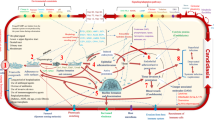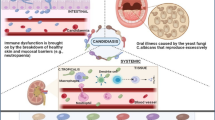Abstract
The characterization of Candida albicans strains with different degrees of virulence became very useful to understand the mechanisms of fungal virulence. Then, the objective of this study was to assess and compare the temporal profiles of biofilms formation, gene expression of ALS1, ALS3, HWP1, BCR1, EFG1, TEC1, SAP5, PLB2 and LIP9 and virulence in Galleria mellonella of C. albicans ATCC18804 and a clinical sample isolated from an HIV-positive patient (CA60). Although the CFU/mL counting was higher in biofilms formed in vitro by ATCC strain, the temporal profile of the analysis of the transcripts of the C. albicans strains was elevated to Ca60 compared to strain ATCC, especially in the genes HWP1, ALS3, SAP5, PLB2 and LIP9 (up regulation). Ca60 was more pathogenic for G. mellonella in the survival assay (p = 0.0394) and hemocytes density (p = 0.0349), agreeing with upregulated genes that encode the expression of hyphae and hydrolase genes of Ca60. In conclusion, the C. albicans strains used in this study differ in the amount of biofilm formation, virulence in vivo and transcriptional profiles of genes analyzed that can change factors associated with colonization, proliferation and survival of C. albicans at different niches. SAP5 and HWP1 were the genes more expressed in the formation of biofilm in vitro.




Similar content being viewed by others
References
Colombo AL, Guimarães T, Camargo LFA, et al. Brazilian guidelines for the management of candidiasis: a joint meeting report of three medical societies. Braz J Infect Dis. 2013;17:283–312.
Mayer LF, Wilson D, Hube B. Candida albicans pathogenicity mechanisms. Virulence. 2013;4:119–28.
Agwu E, Ihongbe JC, McManus BA, et al. Distribution of yeast species associated with oral lesions in HIV-infected patients in Southwest Uganda. Med Mycol. 2012;50:276–80.
Eggimann P, Garbino J, Pittet D. Epidemiology of Candida species infections in critically non-immunosuppressed patients. Lancet Infect Dis. 2003;3:685–702.
Hube B. From comensal to pathogen: stage-and tissue-specific gene expression of Candida albicans. Curr Opin Microbiol. 2004;7:336–41.
Hasan F, Xess I, Wang X, Jain N, Fries BC. Biofilm formation in clinical Candida isolates and its association with virulence. Microbes Infect. 2009;11:753–61.
Finkel JS, Mitchell AP. Genetic control of Candida albicans biofilm development. Nat Rev Microbiol. 2011;9:109–18.
Fox PE, Nobile JC. A sticky situation: untangling the transcriptional network controlling biofilm development in Candida albicans. Transcription. 2012;3:315–22.
Nobile CJ, Mitchell AP. Regulation of cell surface genes and biofilm formation by the C. albicans transcription factor Bcr1p. Curr Biol. 2005;15:1150–5.
Nobile CJ, Mitchell AP. Genetics and genomics of Candida albicans biofilm formation. Cell Microbiol. 2006;8:1382–91.
Nobile CJ, Andes DR, Nett JE, et al. Critical role of Bcr1-dependent adhesins in C. albicans biofilm formation in vitro and in vivo. PLoS Pathog. 2006;2:e63.
Nobile CJ, Fox EP, Nett JE, et al. A recently evolved transcriptional network controls biofilm development in Candida albicans. Cell. 2012;148:126–38.
Pierce VJ, Kumamoto AC. Variation in Candida albicans EFG1 expression enables host-dependent changes in colonizing fungal populations. MBio. 2012;3:e00117-12.
Fanning S, Xu W, Solis N, Woolford CA, et al. Divergent targets of Candida albicans biofilm regulator Bcr1 in vitro and in vivo. Eukar Cell. 2012;11:896–904.
Naglik JR, Rodgers CA, Shirlaw PJ, et al. Differential expression of Candida albicans secreted aspartyl proteinase and phospholipase B genes in human correlates with active oral and vaginal infections. J Infect Dis. 2003;188:469–79.
Naglik JR, Challacombe SJ, Hube B. Candida albicans aspartyl proteinases in virulence and pathogenesis. Microbiol Mol Biol. 2003;67:400–28.
Naglik JR, Albrecht A, Bader O, Hube B. Candida albicans proteinases and host/pathogen interactions. Cell Microbiol. 2004;6:915–26.
Naglik JR, Moyes D, Makwana J, et al. Quantitative expression of the Candida albicans secreted aspartyl proteinase gene family in human oral and vaginal candidiasis. Microbiology. 2008;154:3266–80.
Nailis H, Kucharíková S, Řičicová M, et al. Real- time PCR expression profiling of genes encoding potential virulence factors in Candida albicans biofilms: identification of model-dependent and -independent gene expression. BMC Microbiol. 2010;10:114.
Chamilos G, Lionakis MS, Lewis RE, Kontoyiannis DP. Role of mini-host models in the study of medically important fungi. Lancet Infect Dis. 2007;7:42–55.
Arvantis M, Glavis-Bloom J, Mylonakis E. C.elegans for anti-infective discovery. Curr Opin Pharmacol. 2013;13:769–74.
Fedhila S, Buisson C, Dussurget O, et al. Comparative analysis of the virulence of invertebrate and mammalian pathogenic bacteria in the oral insect infection model Galleria mellonella. J Invertebr Pathol. 2010;103:24–9.
Chibebe Junior J, Fuchs BB, Sabino CP, et al. Photodynamic and antibiotic therapy impair the pathogenesis of Enterococcus faecium in a whole animal insect model. PLoS ONE. 2013;8(2):e55926.
Chibebe Junior J, Sabino CP, Tan X, et al. Selective photoinactivation of Candida albicans in the non-vertebrate host infection model Galleria mellonella. BMC Microbiol. 2013;13:217.
Fanning S, Mitchell AP. Fungal biofilms. PLoS Pathog. 2012;8:e1002585.
Junqueira JC, Fuchs BB, Muhammed M, et al. Oral Candida albicans from HIV-positive individuals have similar in vitro biofilm-forming ability and pathogenicity as invasive Candida isolates. BMC Microbiol. 2011;4:247.
Seneviratne CJ, Silva WJ, Jin LJ, et al. Architectural analysis, viability assessment and growth kinetics of Candida albicans and Candida glabrata biofilms. Arch Oral Biol. 2009;54:1052–60.
Costa ACBP, Pereira AC, Freire F, et al. Methods for obtaining reliable and reproducible results in studies of Candida biofilms formed in vitro. Mycoses. 2013;56:614–22.
Nailis H, Coenye T, Van Nieuwerburgh F, et al. Development and evaluation of different normalization strategies for gene expression studies in Candida albicans biofilms by real- time PCR. BMC Mol Biol. 2006;4:7–25.
Hnisz D, Bardet AF, Nobile CJ, et al. A Histone deacetylase adjusts transcription kinetics at coding sequences during Candida albicans morphogenesis. PLoS Genet. 2012;8:e1003118.
Livak KJ, Schmittgen TD. Analysis of relative gene expression data using real-time quantitative PCR and the 2(-Delta Delta C(T)) Method. Methods. 2001;25:402–8.
Cotter G, Doyle S, Kavanagh K. Development of an insect model for the in vivo pathogenicity testing of yeasts. FEMS Immunol Med Microbiol. 2000;27:163–9.
Kumamoto CA. Candida biofilms. Curr Opin Microbiol. 2002;5:608–11.
Taff HT, Nett JE, Andes DR. Comparative analysis of Candida biofilm quantitation assays. Med Mycol. 2012;50:214–8.
Ramage G, VandeWalle K, Wickes LB, López RJC. Characteristics of biofilm formation by Candida albicans. Rev Iberoam Micol. 2001;18:163–70.
Ramage G, Saville SP, Thomas DP, Lopez-Ribot JL. Candida biofilms: an update. Eukaryot Cell. 2005;4:633–8.
Sánchez-Vargas LO, Estrada-Barraza D, Pozos-Guillen AJ, Rivas-Caceres R. Biofilm formation by oral clinical isolates of Candida species. Arch Oral Biol. 2013;58:1318–26.
Ding X, Liu Z, Su J, Yan D. Human serum inhibits adhesion and biofilm formation in Candida albicans. BMC Microbiol. 2014;14:80.
Buu LM, Chen YC. Impact of glucose levels on expression of hypha-associated secreted aspartyl proteinases in Candida albicans. J Biomed Sci. 2014;21:22.
Semlali A, Killer K, Alanazi H, Chmielewski W, et al. Cigarette smoke condensate increases C. albicans adhesion, growth, biofilm formation, and EAP1, HWP1 and SAP2 gene expression. BMC Microbiol. 2014;14:61.
Yeater KM, Chandra J, Cheng G, et al. Temporal analysis of Candida albicans gene expression during biofilm development. Microbiology. 2007;153:2373–85.
Samaranayake YH, Cheung BPK, Yau JYY, et al. Human serum promotes Candida albicans biofilm growth and virulence gene expression on silicone biomaterial. PLoS ONE. 2013;8:e62902.
Vilela SF, Barbosa JO, Rossoni RD, et al. Lactobacillus acidophilus ATCC 4356 inhibits biofilm formation by C. albicans and attenuates the experimental candidiasis in Galleria mellonella. Virulence. 2015;6:29–39.
Rossoni RD, Barbosa JO, Vilela SFG, et al. Competitive Interactions between C. albicans, C. glabrata and C. krusei during biofilm formation and development of experimental Candidiasis. PLoS ONE. 2015;10:e0131700.
Bergin D, Brennan M, Kavanagh K. Fluctuations in haemocyte density and microbial load may be used as indicators of fungal pathogenicity in larvae of Galleria mellonella. Microbes Infect. 2003;5:1389–95.
Acknowledgements
We acknowledge the São Paulo Council of Research—FAPESP, Brazil (Grants 2011/15194-0, 2012/15250-0 and 2012/02184-9) for supporting this research.
Author information
Authors and Affiliations
Corresponding author
Ethics declarations
Conflict of interest
The authors declare that they have no conflict of interest.
Rights and permissions
About this article
Cite this article
de Barros, P.P., Rossoni, R.D., De Camargo Ribeiro, F. et al. Temporal Profile of Biofilm Formation, Gene Expression and Virulence Analysis in Candida albicans Strains. Mycopathologia 182, 285–295 (2017). https://doi.org/10.1007/s11046-016-0088-2
Received:
Accepted:
Published:
Issue Date:
DOI: https://doi.org/10.1007/s11046-016-0088-2




